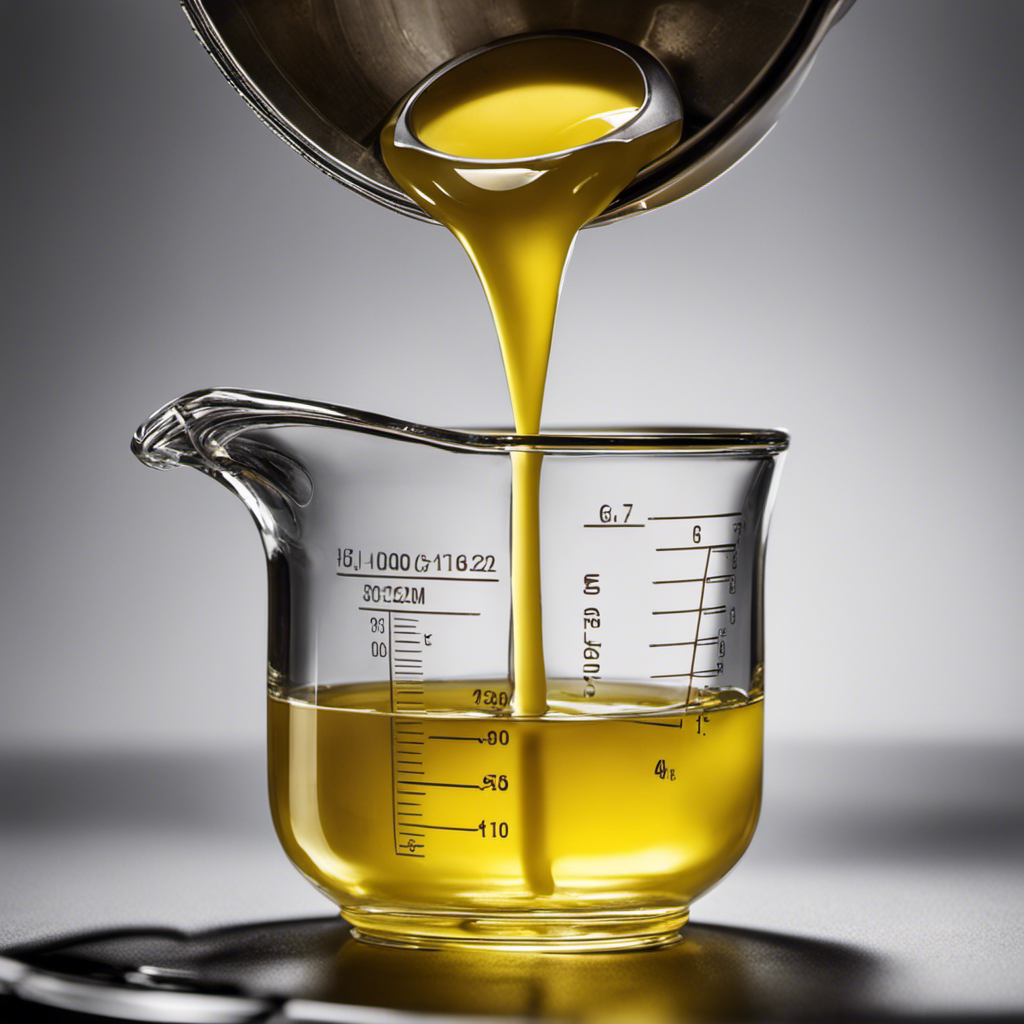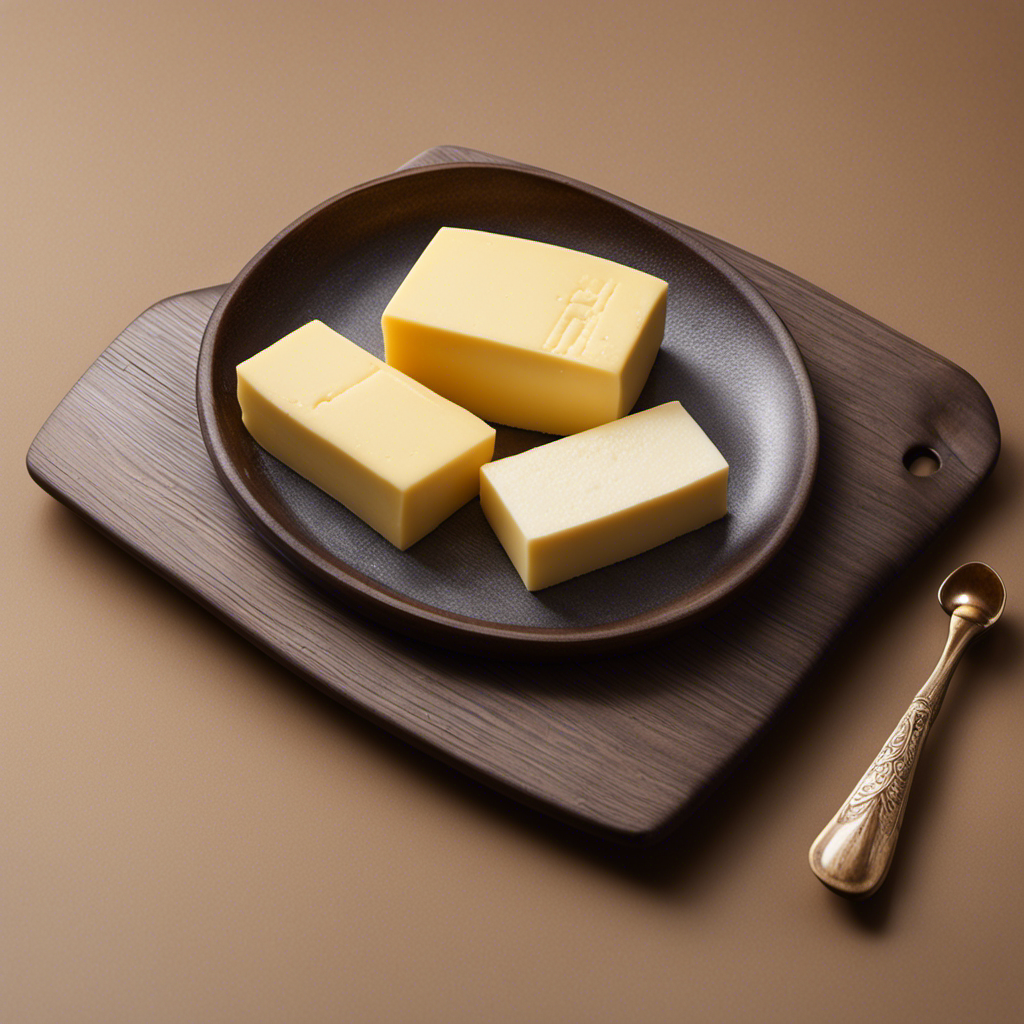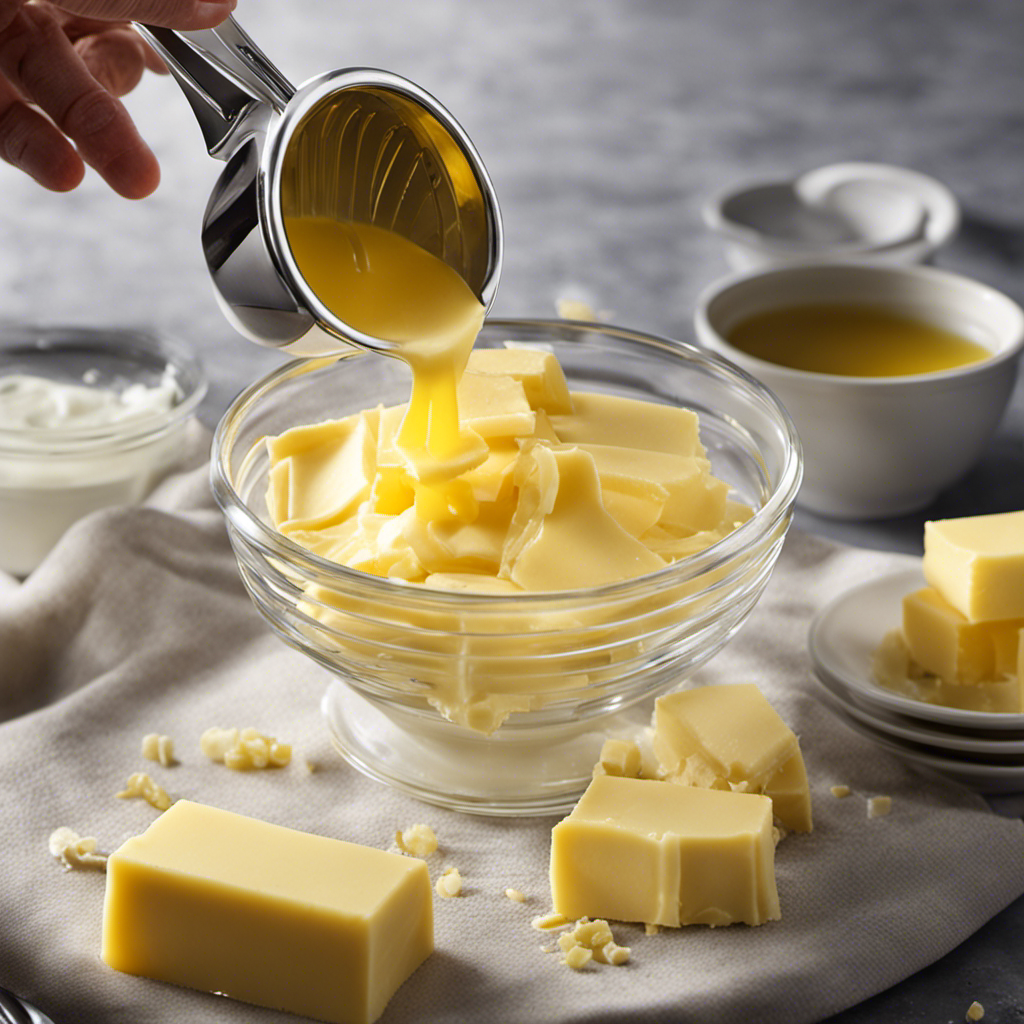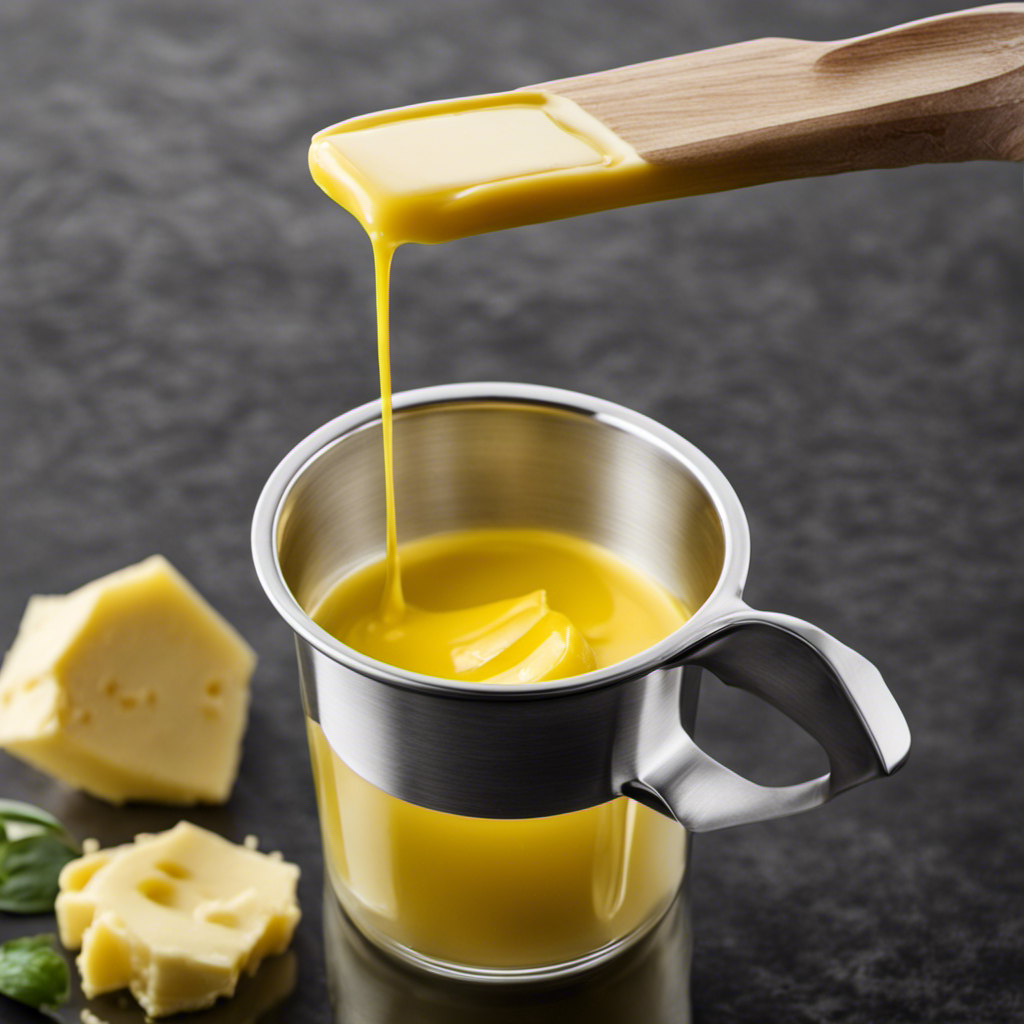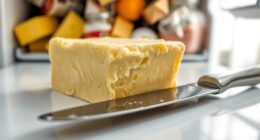I’ve often pondered the number of tablespoons that make up 4 oz of butter. This measurement is frequently utilized in both cooking and baking, and accurate measurement is crucial for the success of a recipe.
So, I did some research and found the answer. In this article, we’ll explore the conversion from ounces to tablespoons, why accurate measurements are important, and provide a handy conversion chart for butter.
Whether you’re a seasoned chef or just starting out in the kitchen, this information will come in handy.
Key Takeaways
- 4 ounces of butter equals 8 tablespoons
- Converting liquid measurements can be tricky
- Accurate measurements are important in cooking and baking
- Understanding metric conversions allows for precise cooking
Understanding the Measurement Conversion
To understand the measurement conversion, you’ll need to know how many tablespoons are in 4 oz of butter.
Converting liquid measurements can be a bit tricky, but once you understand the concept, it becomes much easier. When it comes to metric conversions, it’s important to remember that 1 fluid ounce is equal to 2 tablespoons.
So, if you have 4 ounces of butter, you can simply multiply that by 2 to get the number of tablespoons. In this case, 4 ounces of butter equals 8 tablespoons.
This knowledge is handy when following recipes or trying to figure out the right amount of ingredients to use. Understanding metric conversions allows you to accurately measure and convert various liquid measurements, making your cooking experience more precise and enjoyable.
Converting Ounces to Tablespoons
Converting 4 oz of butter to tablespoons is a simple process. Here’s how to do it:
- Grab your measuring spoon set and select the tablespoon.
- Scoop up the butter using the tablespoon, making sure to level it off for an accurate measurement.
- Repeat this process until you have filled the tablespoon four times.
- Pour the butter from the tablespoon into a separate container, and voila! You now have 4 tablespoons of butter.
Understanding butter measurements is essential for achieving desired results in baking and cooking. Precise measurements ensure that your recipes turn out just right, with the perfect balance of flavors and textures.
Whether you’re making a flaky pie crust or a creamy sauce, accurate measurements play a crucial role in achieving culinary success. So, let’s dive deeper into the importance of accurate measurements and how they can elevate your cooking and baking endeavors.
The Importance of Accurate Measurements
When it comes to baking, precision is key. Ensuring accurate measurements can make the difference between a successful batch of cookies and a disappointing flop.
In this discussion, we will explore the importance of precision in baking and how it can help you avoid recipe mishaps.
Precision in Baking
Baking requires precise measurements, so it’s important to know how many tablespoons are in 4 oz of butter. Accurate tablespoon measurements are crucial for achieving the perfect consistency and taste in your baked goods. Here are four reasons why precision in baking is essential:
-
Consistency: Precise measurements ensure that your recipes turn out the same way every time, allowing you to create consistent and reliable results.
-
Texture: Accurate measurements help you achieve the desired texture in your baked goods, whether it’s light and fluffy or dense and chewy.
-
Flavor: Proper measurements ensure that the flavors are balanced, creating a harmonious taste in your treats.
-
Success: Baking is a science, and precision is the key to success. By following accurate measurements, you increase your chances of baking something truly delicious.
With precision in mind, let’s move on to how to avoid recipe mishaps.
Avoid Recipe Mishaps
To avoid recipe mishaps, you’ll want to pay attention to the instructions and double-check your measurements.
One common mistake that can occur in baking is not understanding butter consistency. Butter should be at room temperature for most recipes, which means it should be soft enough to easily spread but not melted. This ensures that it incorporates properly into the other ingredients and creates the desired texture in the final product.
Another issue that can arise is measurement errors. It’s essential to use the correct measuring tools and follow the recipe’s instructions precisely. Using too much or too little of an ingredient can throw off the balance and result in a disappointing outcome.
Converting Butter From Ounces to Tablespoons
When it comes to baking, accurate measurements are crucial for achieving the perfect results. One common measurement conversion that often comes up is converting ounces of butter to tablespoons.
Knowing how many tablespoons are in a specific amount of butter can make a significant difference in the outcome of your recipe. In this discussion, we will explore the process of converting butter from ounces to tablespoons and the importance of accurate tablespoon measurements in achieving the desired texture and flavor in your baked goods.
Butter Measurement Conversion
The most common measurement conversion for butter is 1 stick, which is equal to 8 tablespoons. When it comes to converting butter in recipes, knowing the measurement equivalents can be a game-changer.
Here are four butter measurement conversions that will make your baking adventures a breeze:
-
1 cup of butter = 2 sticks = 16 tablespoons: This is a handy conversion to know, especially when a recipe calls for a larger quantity of butter.
-
1 tablespoon of butter = 1/2 ounce: If you need a smaller amount of butter, this conversion will come in handy. It’s perfect for adding a touch of richness to your dishes.
-
1/4 cup of butter = 4 tablespoons = 2 ounces: This conversion is great for recipes that call for a specific amount of butter, but you don’t have a measuring cup on hand.
-
1 pound of butter = 4 sticks = 32 tablespoons: This conversion is useful when you need to scale up or down a recipe that requires a pound of butter.
Knowing these butter measurement equivalents will ensure that your recipes turn out delicious every time. So, go ahead and get creative in the kitchen with confidence!
Ounces to Tablespoons
Converting ounces to tablespoons is a simple way to measure butter for your recipes. Understanding conversion ratios can help you measure accurately and ensure that your recipes turn out just right.
When converting ounces to tablespoons, it’s important to remember that 1 ounce of butter is equal to 2 tablespoons. So, if you have 4 ounces of butter, you would need 8 tablespoons.
To measure accurately, use a tablespoon measure or a kitchen scale to weigh the butter. If you don’t have a scale, you can also use the markings on the butter wrapper as a guide. Simply cut the butter along the lines to get the desired amount.
Accurate Tablespoon Measurements
Accurate measurements can be obtained by using a kitchen scale to weigh the butter. This is important because understanding conversion ratios and avoiding common measurement mistakes can greatly impact the outcome of your recipe.
Here are four reasons why accurate tablespoon measurements matter:
-
Consistency: Accurate measurements ensure that your recipes turn out the same every time, giving you reliable results that you can trust.
-
Balance of flavors: By using the correct amount of butter, you can achieve the perfect balance of flavors in your dish, whether it’s a savory sauce or a sweet baked good.
-
Texture: Adding too much or too little butter can affect the texture of your recipe. Precise measurements ensure that your dish has the desired consistency, whether it should be light and fluffy or rich and creamy.
-
Waste reduction: By measuring accurately, you can avoid wasting ingredients and money. No more guessing or throwing away excess butter that you didn’t need.
A Handy Conversion Chart for Butter
For a quick reference, here’s a handy conversion chart for butter. Understanding conversions when it comes to butter can be a bit tricky, especially when you’re trying to measure it accurately for your recipes. To help you out, I’ve created a simple table that shows you how many tablespoons are in different amounts of butter. This way, you can easily convert between ounces and tablespoons without any confusion. Just remember, when measuring butter, it’s important to use the correct tools and techniques for accurate measurements. Using a kitchen scale or a measuring spoon specifically designed for butter can ensure that you’re getting the right amount for your recipe. So, next time you’re in the kitchen and need to measure butter, refer to this handy chart for quick and accurate conversions.
| Butter (ounces) | Butter (tablespoons) |
|---|---|
| 1 oz | 2 tbsp |
| 2 oz | 4 tbsp |
| 3 oz | 6 tbsp |
| 4 oz | 8 tbsp |
| 5 oz | 10 tbsp |
How to Measure Butter in Tablespoons
Now that we know how to convert ounces of butter to tablespoons, let’s explore another way to measure butter. As a home cook, I often find myself needing to measure butter in grams for precise recipes. Here are some alternative units for measuring butter:
-
Grams: Measuring butter in grams allows for more accuracy in recipes. It’s especially useful for baking, where precise measurements are crucial.
-
Sticks: In the United States, butter is commonly sold in sticks, which are equivalent to 8 tablespoons or 1/2 cup. This measurement is convenient for many American recipes.
-
Cups: For larger quantities, measuring butter in cups is a popular choice. One cup of butter is equal to 16 tablespoons or 2 sticks.
-
Ounces: Another common unit of measurement is ounces. One ounce of butter is equivalent to 2 tablespoons.
Tips for Perfectly Measuring Butter
To ensure you get the right amount of butter, follow these tips for perfectly measuring it.
When it comes to measuring butter, there are a few alternatives you can use if you don’t have a scale on hand. One tablespoon of butter is equal to about 14 grams or 0.5 ounces. So, if your recipe calls for 4 ounces of butter, you would need approximately 8 tablespoons.
However, it is important to note that different brands of butter may have slightly different measurements, so it’s always a good idea to check the package for specific measurements.
If you’re troubleshooting measurement errors, make sure to use a level measuring spoon and pack the butter tightly into it to get an accurate measurement.
Happy baking!
Converting Butter for Baking Recipes
If you want to convert butter for your baking recipes, it’s helpful to know that one stick of butter is equivalent to 1/2 cup or 8 tablespoons. Understanding butter density can be a game-changer when it comes to converting butter for savory recipes. Here are four reasons why:
-
Consistency: Converting butter accurately ensures the right texture and consistency in your baked goods. Too much or too little butter can affect the final outcome.
-
Flavor: Butter adds a rich and creamy flavor to your baked treats. Converting it correctly ensures that the flavor is balanced and enhances the overall taste.
-
Moisture: Butter contributes to the moisture content of your baked goods. Accurate conversions ensure that your treats are moist and delicious.
-
Success: Converting butter correctly guarantees successful baking results. You’ll avoid any mishaps and create baked goods that are a hit every time.
Understanding butter density and converting it accurately is the key to achieving amazing results in your baking and savory recipes. So go ahead, get your measurements right, and create culinary masterpieces!
Adjusting Recipes With Butter Measurements
When it comes to baking, getting the measurements right can make or break a recipe. One key ingredient that often requires conversions is butter.
Understanding how to convert butter measurements can have a significant impact on the final result of your recipe. In this discussion, we will explore the importance of accurate butter measurements and how it can affect the outcome of your delicious creations.
Butter Measurement Conversions
You can easily convert 4 oz of butter to tablespoons by multiplying it by 8. Converting butter measurements is essential for accurate cooking and baking. Here are some handy butter measurement equivalents to make your culinary adventures easier:
- 1/2 cup of butter is equal to 1 stick or 8 tablespoons.
- 1/4 cup of butter is equal to 4 tablespoons or half a stick.
- 1 tablespoon of butter is equal to 1/8 of a cup or half an ounce.
- 1 pound of butter is equal to 2 cups or 32 tablespoons.
Knowing these conversions allows you to confidently adapt recipes to suit your needs. So, whether you’re whipping up a batch of cookies or sautéing vegetables, understanding butter measurements ensures your dishes turn out just right.
Happy cooking!
Impact on Recipe Results
Understanding the impact of butter measurement conversions is key to achieving accurate and consistent recipe results. Ensuring measurement accuracy is crucial in baking, as even small variations can significantly affect the outcome of your baked goods. As a home baker, I have experienced the frustration of using the wrong butter measurement and ending up with a dense cake or crumbly cookies. To help you avoid such mishaps, here is a table that shows common butter measurement conversions:
| Butter Measurement | Equivalent in Tablespoons |
|---|---|
| 1 oz | 2 tablespoons |
| 2 oz | 4 tablespoons |
| 3 oz | 6 tablespoons |
| 4 oz | 8 tablespoons |
Common Mistakes in Butter Measurement
One common mistake people make when measuring butter is not realizing that 4 oz is equal to 8 tablespoons. This can lead to inaccurate measurements and affect the final outcome of your recipe.
To help you avoid this error, here are four common measurement mistakes to watch out for:
-
Eyeballing it: Guessing the amount of butter instead of using a proper measuring tool can result in too much or too little butter in your recipe, throwing off the balance of flavors and textures.
-
Using the wrong measuring cup: Using a liquid measuring cup instead of a dry measuring cup can lead to incorrect measurements. Butter is a solid, so it should be measured using a dry measuring cup or weighed on a kitchen scale.
-
Not softening the butter: Recipes often call for softened butter, but many people forget to bring it to room temperature. Using cold or melted butter can change the consistency of your baked goods.
-
Ignoring conversions: Converting measurements from ounces to tablespoons is crucial for accuracy. Not doing so can result in using the wrong amount of butter, which can affect the texture and taste of your dish.
By being mindful of these common mistakes, you can ensure accurate measurements and achieve the best results in your cooking and baking endeavors.
Now let’s explore how to convert other ingredients from ounces to tablespoons.
Converting Other Ingredients From Ounces to Tablespoons
After learning about the common mistakes in measuring butter, let’s delve into understanding conversions for other ingredients, specifically converting ounces to tablespoons. This is a crucial skill in the kitchen, as it ensures accurate measurements and successful recipes.
One common measurement mistake is assuming that all ingredients have the same conversion rate from ounces to tablespoons. However, this is not the case. Different ingredients have different densities, which affects their conversion rates. For example, 4 ounces of butter is equal to 8 tablespoons, but 4 ounces of flour is equal to approximately 7 tablespoons.
To avoid mistakes, it’s important to consult a reliable conversion chart or use a kitchen scale to measure ingredients accurately. Understanding these conversions will not only prevent errors in your recipes but also guarantee delicious and perfectly balanced dishes.
Frequently Asked Questions
Can I Substitute Margarine for Butter in a Recipe?
I think it’s possible to substitute margarine for butter in a recipe. However, it’s important to consider that butter is generally considered healthier than margarine. Here are some tips for successfully substituting margarine in baking.
How Do I Convert Grams to Tablespoons for Butter?
Converting butter measurements can be tricky, especially when you don’t have a tablespoon. But fear not! I’ll show you how to convert grams to tablespoons for butter, making your measurements a piece of cake.
Is It Possible to Measure Butter Without a Tablespoon?
Measuring butter using a kitchen scale is a precise way to convert butter measurements from ounces to grams. It allows you to accurately portion out the desired amount, eliminating the need for a tablespoon.
How Many Tablespoons Are in a Stick of Butter?
When it comes to measuring butter, a stick typically equals 8 tablespoons. However, if you’re substituting margarine, keep in mind that it has a higher water content, so you may need to adjust your measurements accordingly.
How Do I Convert Butter Measurements From Cups to Tablespoons?
Converting butter measurements is simple. To convert from cups to tablespoons, multiply the number of cups by 16. For example, if you have 1 cup of butter, it would be equivalent to 16 tablespoons.
Conclusion
In conclusion, understanding how to convert measurements is essential for accurate cooking and baking.
Converting ounces to tablespoons allows for precise measurements, especially when it comes to ingredients like butter.
While some may argue that using a kitchen scale is more accurate, having a handy conversion chart can be incredibly helpful and convenient.
By mastering these conversions, you can confidently adjust recipes and avoid common mistakes.
So next time you’re in the kitchen, remember the importance of accurate measurements and enjoy your delicious creations!
